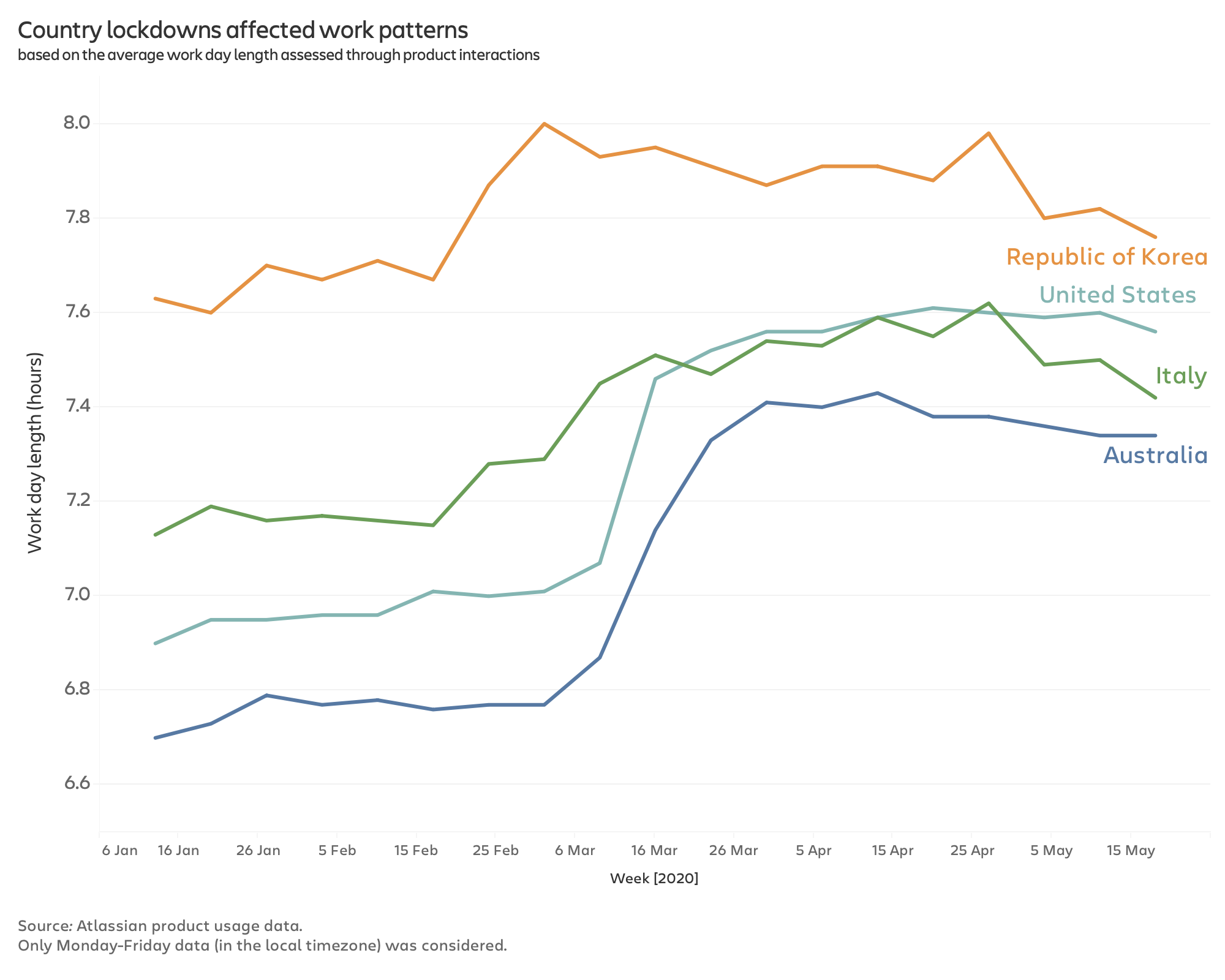We suspected the workday was bleeding farther into your personal time, but we couldn’t prove it. Until now.
The grand (if unplanned) remote work experiment we find ourselves in has been a boon for some and a burden for others. Throughout this experience, I’ve sensed that working from home blurs the boundaries between our professional and personal lives, putting us at risk of burning out en masse.
But I couldn’t back up that feeling with facts until now.
In my role as Principal Data Scientist at Atlassian, I spend a lot of time looking at user behavior. With usage data from millions of people across the world at my fingertips, I wondered whether activity patterns could illuminate changes in our collective work habits with the transition to remote work.
Are we starting work earlier? Stopping later? Has taking a break for lunch been canceled? I joined forces with fellow data scientists Pedro Queiroz, Praveen Bysani, and Shahin Elliin to investigate.
What we looked at and we what we found
To understand changes to the workday, we looked at analytics events from Jira, Confluence, and Bitbucket. Although plenty of work takes place outside these tools, the aggregated data is sufficient to identify patterns.
We focused on events that reflect direct interactions with the user interface to reduce the chances of capturing activity from scripts or system events. The data we analysed included actions like creating a document, updating a ticket, and commenting on a code review.
We used the first and last time of user activity – Monday through Friday for most countries (but not for all), rounded to 5-minute intervals – as indicators of the start and end of the workday. The time between these end-points approximates the length of the workday.
By April, our workdays were longer
The impact of lockdowns on our customers was consistent with the patterns we observed amongst our own staff: a striking change took place in March, with workdays becoming significantly longer by April.

How much longer? To answer that, we first aggregated data from January 2020 – February 2020, when employees were generally working from corporate offices. We then compared that to data from April 2020 – May 2020, at which point most knowledge workers worldwide were working from home. In some countries (Israel and India, for example) the differences are more pronounced. In others, like Korea, the impact is hardly noticeable. But the difference is irrefutably real.
We also looked at the intensity of work throughout the day, measured by the number of active users at any given time, and shown in the chart below. Because we were looking at the distribution of work throughout the day, the data capture the proportion of activity at each time compared to the rest of the day. Think of it this way: working an extra hour in the evening doesn’t necessarily mean you’re working less in the morning; it’s just that mornings now comprise a smaller relative proportion of the workday.
Perhaps these graphs don’t look so dramatic. But when we zoom in on the differences between the distribution of work before and after lockdowns, the plot thickens. Here we can see the times of day in which the proportion of user activity increased (in blue) versus decreased post-lockdown (in orange).
So what does it all mean?
The lockdowns due to COVID-19 have pushed many industries to embrace remote work, temporarily or permanently. This poses a challenge for employees, who are trying to adjust to work in new settings, as well as for employers, who need to keep their businesses running throughout this big change.
The patterns we observed suggest that the boundaries between home and office blur, and companies and employees need to adjust their practices to this new world. This was further confirmed by qualitative data from a study commissioned by Atlassian and conducted by research firm Paper Giant in July 2020. Even those without caregiving responsibilities reported struggling to delineate between work time and personal time, and were prone to working long hours without pausing for a break. Over half of respondents said it’s harder now to maintain work-life boundaries than before the pandemic, and 23% reported thinking about work during their off-hours more than they used to.
In other words, we need to find effective ways of “switching off” or risk burning out.
Because team leads and executives set the tone for their organizations, they have a special role to play. First, they can devote a portion of 1-on-1 meetings to checking in on their team members’ well-being and chatting about what’s going on outside of work. This helps build the rapport needed for employees to feel valued and heard. Leaders can also encourage team members to set reminders on their calendars for when it’s time to take a break or stop work for the day. And most importantly, they can set an example by muting notifications on their phones after hours and taking time off to recharge.
Remote work will be part of our lives to some extent for a long time. The question now is whether we can find a way to make remote work work – for everyone.

